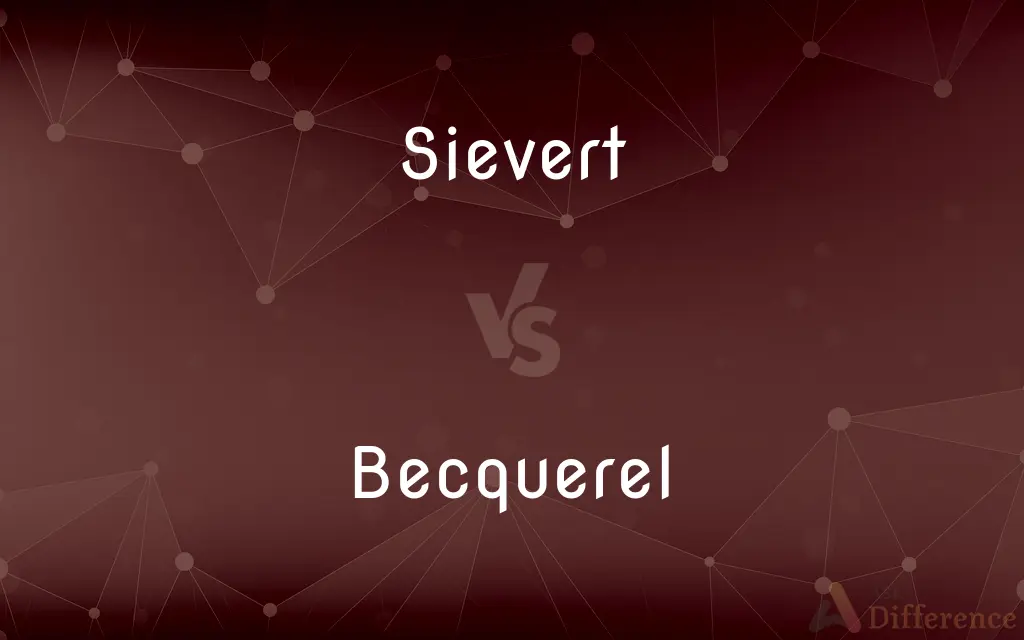Sievert vs. Becquerel — What's the Difference?
By Urooj Arif & Fiza Rafique — Updated on March 21, 2024
The sievert measures radiation dose's effect on human tissue, while the becquerel quantifies radioactive decay's activity.

Difference Between Sievert and Becquerel
Table of Contents
ADVERTISEMENT
Key Differences
The sievert (Sv) is a unit of ionizing radiation dose in the International System of Units (SI) and measures the health effect of low levels of ionizing radiation on human tissue. It takes into account the type of radiation and its energy, providing a measure of the risk of radiation exposure. In contrast, the becquerel (Bq) is the SI unit for measuring the rate of radioactive decay, indicating the quantity of radioactive material by the number of disintegrations per second.
While the sievert assesses the biological effects of radiation, allowing for an understanding of potential damage to living tissues and the associated risk of cancer, the becquerel focuses purely on the physical aspect of radioactivity without regard to the type or energy of the radiation or its biological effects. This distinction highlights the sievert's role in radiation protection and health physics, compared to the becquerel's application in measuring radioactive materials' activity.
The sievert is used in fields like radiology, nuclear medicine, and radiation protection to ensure that the doses received by patients, workers, and the public remain within safe limits. On the other hand, the becquerel is utilized in nuclear physics, environmental monitoring, and various applications requiring precise measurements of radioactive decay, such as dating archaeological findings or monitoring environmental contamination.
Given the complexity and potential for harm associated with ionizing radiation, the sievert incorporates factors like radiation type and energy, as well as weighting factors for different tissues, to provide a comprehensive measure of radiation dose effectiveness. Meanwhile, the becquerel, being a direct measure of radioactivity, serves as a fundamental unit for describing the rate at which radioactive processes occur, irrespective of the radiation's impact on living tissue.
The application of the sievert in evaluating radiation exposure's health risks reflects a focus on safety and prevention, guiding policies and practices in occupational health and public safety. Conversely, the becquerel's function in quantifying radioactivity levels supports its use in scientific research, environmental assessment, and the management of radioactive substances.
ADVERTISEMENT
Comparison Chart
Definition
Measures the health effect of ionizing radiation on tissue
Measures the rate of radioactive decay
Focus
Biological effects of radiation
Physical activity of radioactivity
Usage Field
Radiology, nuclear medicine, radiation protection
Nuclear physics, environmental monitoring
Measures
Radiation dose's effect on human health
Quantity of radioactive material
Importance
Guides safety practices in exposure limits
Quantifies radioactivity for scientific applications
Compare with Definitions
Sievert
Measures radiation dose impact on health.
A chest X-ray typically delivers about 0.1 millisievert.
Becquerel
Quantifies the activity of a radioactive substance.
The uranium ore emits 2000 becquerels per gram.
Sievert
A unit for the biological effect of radiation.
The radiation workers' exposure was 5 millisieverts last year.
Becquerel
A unit for radioactive decay rate.
The sample's activity was measured at 100 becquerels.
Sievert
Incorporates radiation type and tissue sensitivity.
Gamma rays and alpha particles have different effects, measured in sieverts.
Becquerel
Used in dating archaeological findings.
Carbon dating relies on becquerel measurements to estimate ages.
Sievert
Indicates risk of cancer from radiation.
Increased sieverts increase the statistical risk of developing cancer.
Becquerel
Essential for environmental radiation monitoring.
Radioactivity in groundwater is monitored in becquerels.
Sievert
Used in safety guidelines for radiation exposure.
Regulatory limits for nuclear industry workers are expressed in sieverts.
Becquerel
Independent of biological effects.
Becquerel measurements focus solely on decay rates, not health impact.
Sievert
The sievert (symbol: Sv) is a derived unit of ionizing radiation dose in the International System of Units (SI) and is a measure of the health effect of low levels of ionizing radiation on the human body. The sievert is important in dosimetry and radiation protection, and is named after Rolf Maximilian Sievert, a Swedish medical physicist renowned for work on radiation dose measurement and research into the biological effects of radiation.
Becquerel
The becquerel (English: ; symbol: Bq) is the SI derived unit of radioactivity. One becquerel is defined as the activity of a quantity of radioactive material in which one nucleus decays per second.
Sievert
The SI unit for the amount of ionizing radiation required to produce the same biological effect as one rad of high-penetration x-rays, equivalent to a gray for x-rays.
Becquerel
The International System unit of radioactivity, equal to one nuclear decay or other nuclear transformation per second.
Sievert
In the International System of Units, the derived unit of radiation dose; the dose received in one hour at a distance of 1 cm from a point source of 1 mg of radium in a 0.5 mm thick platinum enclosure. Symbol: Sv
Becquerel
In the International System of Units, the derived unit of radioactive activity; the activity of a quantity of radioactive material in which one nucleus decays per second. Symbol: Bq
Becquerel
French physicist who discovered that rays emitted by uranium salts affect photographic plates (1852-1908)
Common Curiosities
Can sievert measurements indicate the type of radiation?
Yes, sievert measurements consider the type of radiation and its biological effects, using weighting factors.
What does the becquerel measure?
The becquerel measures the rate of radioactive decay, indicating the quantity of radioactive material.
Why is the becquerel important in environmental monitoring?
The becquerel helps quantify environmental radioactivity levels, crucial for assessing contamination and safety.
What unit is used to set safety limits for radiation workers?
Safety limits for radiation workers are often set in sieverts, reflecting permissible exposure levels to minimize health risks.
What is a sievert?
The sievert is a unit that measures the health effects of ionizing radiation on human tissues, accounting for the type and energy of radiation.
How do sieverts and becquerels differ in application?
Sieverts are used in health physics to assess radiation exposure risks, while becquerels are used in nuclear physics and environmental monitoring to measure radioactivity.
How do sieverts relate to cancer risk?
Higher sievert exposures increase the statistical risk of cancer due to the damaging effects of ionizing radiation on DNA.
How does the application of becquerels support nuclear safety?
By measuring radioactive material's decay rate, becquerels aid in tracking and managing radioactivity, supporting safety measures in nuclear facilities and the environment.
What factors influence the conversion of becquerels to sieverts?
Converting becquerels to sieverts requires considering the type of radiation, its energy, and the exposure scenario, including the tissues affected.
How does the sievert account for different types of radiation?
The sievert uses weighting factors for different types of radiation to reflect their varying biological impacts.
Is the becquerel affected by radiation type or energy?
No, the becquerel measurement is independent of radiation type or energy, focusing only on the rate of decay.
What is the significance of measuring radiation in sieverts?
Measuring radiation in sieverts is significant for evaluating the potential health risks and ensuring radiation exposure remains within safe limits.
Can the sievert be used to measure radiation exposure from medical procedures?
Yes, the sievert is used to measure and communicate the radiation dose received from medical procedures, such as X-rays and CT scans.
How are sieverts and becquerels related to public health?
Both units play crucial roles in public health by measuring and managing radiation exposure (sieverts) and monitoring radioactivity levels (becquerels) to protect against potential health risks.
Why is the becquerel used in dating archaeological findings?
The becquerel is used in radiocarbon dating to measure the decay rate of carbon-14, helping to estimate the age of organic materials.
Share Your Discovery

Previous Comparison
Reinsure vs. Reassure
Next Comparison
Pomolo vs. PomeloAuthor Spotlight
Written by
Urooj ArifUrooj is a skilled content writer at Ask Difference, known for her exceptional ability to simplify complex topics into engaging and informative content. With a passion for research and a flair for clear, concise writing, she consistently delivers articles that resonate with our diverse audience.
Co-written by
Fiza RafiqueFiza Rafique is a skilled content writer at AskDifference.com, where she meticulously refines and enhances written pieces. Drawing from her vast editorial expertise, Fiza ensures clarity, accuracy, and precision in every article. Passionate about language, she continually seeks to elevate the quality of content for readers worldwide.














































